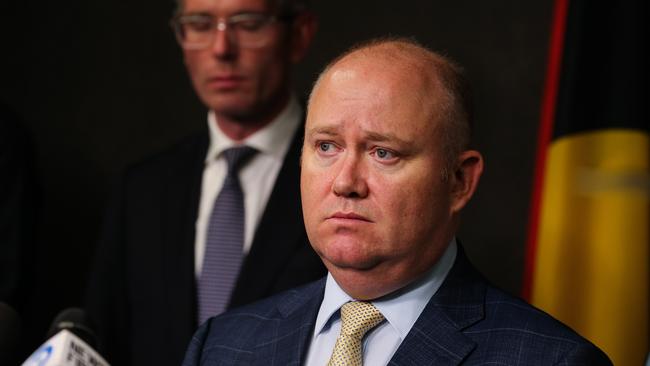James O’Doherty: Is Resilience NSW set for the chopping block?
Resilience NSW may be misunderstood, but it needs to do more to help flood regions — starting with raising Warragamba Dam wall, writes James O’Doherty.
Opinion
Don't miss out on the headlines from Opinion. Followed categories will be added to My News.
During Premier Dominic Perrottet’s most recent trip up to Lismore on Thursday, he was at pains to point out that among the people he has met, many have been appreciative of the government’s work in the flood clean-up.
Perrottet indicated the media has unfairly portrayed locals as universally scathing, when his experience was far more positive.
The Premier can’t be blamed for grasping on to some positive reception where he can get it, because there is growing unrest in his government’s own ranks about how the disaster has been managed.
And, as residents from the state’s north coast to Sydney’s west begin the clean-up from record-breaking floods, some of the mud they are shovelling out of their homes is likely to stick to those in charge.

One of the main criticisms from government MPs this week has been the role of Resilience NSW bureaucrats, led by Shane Fitzsimmons, in the recovery effort.
There is widespread confusion about what the relatively new agency was set up to do when it was established by former Premier Gladys Berejiklian in 2020.
Anger has also been directed at Deputy Premier Paul Toole and Emergency Services Minister Steph Cooke. Some Nationals MPs are furious that Toole, as Deputy Premier, did not take on the added portfolio responsibility of Flood Recovery Minister this week.
That role was instead handed to Steph Cooke, who was already copping criticism from colleagues who think she isn’t up to the job.
There is a view Cooke is ill-suited to the high-stress role of Emergency Services Minister, and adding Flood Recovery on top of that compounds an unmanageable workload.
Critics also believe that a local MP should have been asked to step up to help northern NSW recover, not someone from the Riverina (Cooke is the MP for Cootamundra).
Toole and Cooke will survive the criticism from colleagues, but it is unclear whether Fitzsimmons’ Resilience NSW will weather the storm of public critique.

As Berejiklian said at the time, the agency was designed to help NSW “prevent, prepare and recover” from crises. But since its inception, its impact on preparation has been lacking.
It’s available budget in 2021-22 of almost $1.4 billion (most of which was to be spent on recovery grants) could have covered the lion’s share of the cost of raising the Warragamba Dam wall by 14m to protect homes in Western Sydney.
The proposal remains locked up by red tape pending the final result of a long-awaited environmental impact statement consultation process.
As The Daily Telegraph reported last month, the number of homes lost in last year’s floods would have been dramatically reduced if the dam wall had been raised.
“The number of impacted dwellings and manufactured homes would have reduced by around 80 per cent and 60 per cent, respectively,” an Infrastructure NSW report said.
If Resilience NSW bureaucrats want to help Western Sydney prepare for future flooding disasters, it could turn its attention to getting the Warragamba Dam wall project off the ground.

And despite Resilience NSW spending most of its budget on grants administered through other agencies, towns like Lismore have largely missed out on state government money for flood management.
The flood-ravaged town has been stymied by a cumbersome grants process which requires the council to stump up a third of the cost of flood management projects just to get a look-in for state government funding.
An Environment Department spokesman this week identified about $8.6 million in state government grant funding that had gone to Lismore for the purposes of flood management. Of this, $8.2 million was allocated to “improve flood conveyance” by excavating earth from the Lismore Airport floodway.
Just over $187,000 was granted to Rous County Council for house raising in Lismore and the rest went to updating floodplain risk management plans.
I can reveal that Lismore City Council last year applied for a state government grant to fund five new flood gauges, three CCTV cameras and a “community flood dashboard”.
However, because its most recent “Floodplain risk management plan” hasn’t been finalised, the application was deferred.
This is the kind of red tape that Resilience NSW could try to clear away. The agency should also be making it easier for one of the state’s most flood-prone areas to get money for flood mitigation.
The agency has seemingly done little to help councils like Lismore invest in flood mitigation efforts.

Instead, Resilience NSW has spent its money on sending out “Get Ready” campaign packs to councils so they can tell constituents how to prepare for disasters, which included social media templates, posters, calendars and other materials to help inform communities.
Perrottet has no appetite to axe the agency in the middle of a natural disaster but a wide-ranging review of the government’s response to the floods could put Resilience NSW in danger.
As Treasurer, Perrottet was opposed to the new agency. Former Deputy Premier John Barilaro was, too. It was Berejiklian’s brainchild, seen by its critics as a way to reward Shane Fitzsimmons for his (valiant) efforts as Rural Fire Service Commissioner.
Its biggest problem is that its role is largely misunderstood. Those who defend the agency say that it is still finding its feet.
But if its role is to help NSW prepare for natural disasters, Resilience NSW needs to do more than just fund campaign materials and social media templates.



